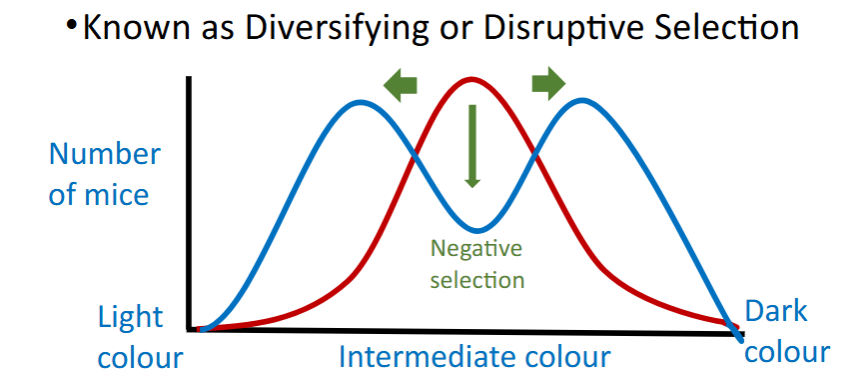Evolution and Natural Selection
History of natural selection
-natural theology
-Aristotle 382-322 BC
scale of nature
James Hutton and Charles Lyall developed the theory of Gradualism which is supported by the fossil record.
Fossil record
Newer rocks have different shape to older rocks. Gradual changes were observed.
Jean Baptiste Lammarck
-developed the first major theory of evolution
organisms could adapt to their environment
changes in individuals were passed on from generation to generation (red bit turned out to be wrong)
Charles Darwin
-published “origin of species“
collected data from his trip on HMS Beagle
examples he found were “Darwin’s finches“
Over 13 different species had evolved from a common ancestor and adapted to different ecological niches.
Darwin’s theory of natural selection: Descent by modification
1.Principle of Variation
inherent variability in population
2.Principle of Heredity
variation is passed down through generations
3.Principl of selection
organisms tend to over multiply
some individuals have a greater capacity to survive or reproduce
Evidence for natural selection
Biogeography
the adaptation of organisms to their environment e.g. Darwin’s finches
Fossil record
insert fossil picture
Comparative anatomy
evolve from common structures e.g. mammalian forelim
insert arm photo
evolve from common structure
insert second arm photo
Comparative embryology
common development structures e.g. human versus chick embryo
Similarities in DNA sequence show common origins
chimps and humans share 98% similarity in their DNA sequence
dogs and humans share 85% similarity in their DNA sequence
Principle of variation
Genetic polymorphism
changes to the DNA sequence
Phenotypic polymorphism
changes in the appearance or measurable characteristics.
poly = many
morphism = types of forms
Genotype - DNA sequence
Phenotype - function or appearance
variability due to changes in the DNA
Mechanisms that generate variation
Gene mutation
changes in DNA sequences in single or multiple genes e.g. eye colour mutants in Drosophilia
Chromosome mutation
changes in the umber of chromosomes e.g. down syndrome
Recombination
new arrangements caused by sexual reproduction
Principle of heredity
A species
all members of the same species can interbreed
not all have the opportunity
A population
A group of organisms within the same species that do have the opportunity to interbreed

Principle of selection
All organisms tend to over-reproduce
the best adapted out-compete others
“selective pressure“ is the term given to the factors that cause this competition.
Selective pressures
Evasion of predators
these best adapted evade predators more effectively e.g. the Pennered moth

Competition for food e.g. giraffe
Resistance to disease
some animals/people are more resistant to disease than others
e.g. African cattle more resistant to sleeping sickness parasites than European cattle
selection for metabolic fitness
some organisms utilise resources more efficiently than others
e.g. micro-organisms can adapt to a wide range of food sources
Sexual selection
partner choose mate
e.g. all types of mating displays
Resistance to toxins or drugs
organisms develop resistance to chemicals
e.g. antibiotic resistance in bacteria in hospitals
Artificial selection
humans have deliberately selected animals/plants
e.g. all domestic breeds of animals and crops
Principle of selection: changes in gene frequencies

Modes of selection
In a field of mice with natural variation in coat colour some mice may have very light colouration, other very dark but the majority have an intermediate colour. This can be depicted as a frequency distribution








Balanced selection
sometimes more than one selective pressure acts at the same type but has opposite effects
e.g. sickle cells Anaemia and malaria in Africa
Sickle cell is a fatal human disease - negative selection but provides partial protection against malaria
Malaria is a fatal human disease - negative selection

Modes of reproduction
Asexual organisms

rapid reproduction
limited variability - genetically “clonal“
limited adaptability

Higher variability
Higher adaptability
Lower reproductive rate
Speciation
formation of new species
estimated about 100 new species are formed each year
one mechanism involves diversifying selection

This is known as cladogenesis
clade = a group
genesis = birth of
cladogenesis = birth of groups
Speciation
formation of new species
one mechanism is called Anagenesis
A or An = without
“without the birth of groups“

Mechanisms of separation of populations
often referred toas isolation of populations
mechanisms that cause barriers to mating between populations
Genetic isolation of populations
Geographical isolation

Geographical isolation causes the formation of new species in a different place this is known as ALLOPATRIC speciation
When speciation occurs at the same place this is known as SYMPATRIC speciation
(patric = place; allo = differeny; sym = same)
Habitat isolation
populations evolve to occupy the same space but use different resources
this is an example of sympatric speciation
e.g. Darwin’s finches
3. Behavioural isolation
organisms evolve different behaviours to prevent mating between different species
e.g. fireflies, males have a flashing light pattern and there are different patterns for different species
Temporal isolation
organisms evolve different timing to prevent mating between different species
e.g. western USA spotted skunks mate in summer and eastern USA spotted skunk mate in winter
Mechanical isolation
organisms evolve different mating apparatus to prevent mating between different species
e.g. spiders - male sex organs (the pedipalps) have to be the perfect shape… or else…
if the grooves on the male pedipalps are not the right shape he will get eaten
Gametic isolation
organisms evolve sperm and egg incompatibility to prevent mating between different species
e.g. fish - female lay eggs on a river bed and males spread sperm over the eggs, lots of possibilities for wrong sperm to meet wrong egg.
Hybrid sterility
sometimes different species can interbreed but they usually produce sterile off springs
e.g. mules are infertile off springs of female horse x male donkey
rth of groups